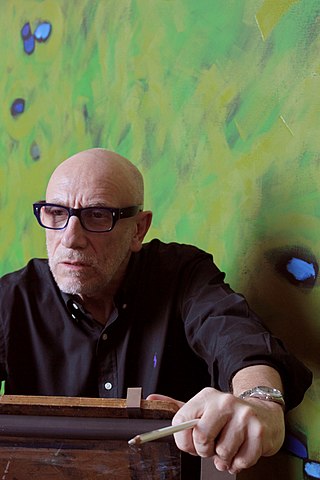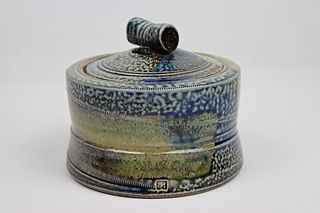
Paul Cummins MBE (born 26 September 1977) is an English artist from Chesterfield, Derbyshire, who produces landscape installations using ceramic flowers.

Paul Cummins MBE (born 26 September 1977) is an English artist from Chesterfield, Derbyshire, who produces landscape installations using ceramic flowers.
Cummins worked as a maker of architectural models, and then studied ceramics at the University of Derby's College of Arts. He has colour associated dyslexia, [1] and was one of the artists with disabilities commissioned by the London 2012 Cultural Olympiad, the UK Arts Councils and the British Council to produce works for Unlimited, a programme celebrating disabled artists' work in the run up to and during the London 2012 Olympics [2] and Paralympics. [3]
Cummins conceived the monumental installation Blood Swept Lands and Seas of Red at the Tower of London, which commemorated the British and Colonial losses in the First World War with 888,246 ceramic poppies. Cummins produced the flowers together with a number of assistants in Derbyshire, while the setting of the work was designed by theatre designer Tom Piper. [4] During the making of the work in his workshop, Cummins accidentally crushed his hand in an industrial roller. This left him requiring extensive surgery and resulted in the loss of a finger and use of his dominant hand. [5] He said in interviews that was "overwhelmed" by the public response to this work, saying "I think that it is something everybody can relate to and they feel very personally about." However, he also received death threats for his work, stating that it was because the money was being donated to "war charities". [6] In recognition of the success of the work, both Cummins and Piper were awarded the MBE in the 2015 New Year Honours, Cummins' award being made "for services to art and First World War commemorations". [7] [8] [9]
Other clients for which Cummins has produced work include Chatsworth House, Hardwick Hall and Blenheim Palace. [10] He is currently[ when? ] studying for a PhD at the University of Derby, and lecturing in crafts. The university awarded him an Honorary Master of Arts in January 2015. [11] He was awarded an honorary PhD by London Metropolitan University in July 2015. [12]
In 2015, Cummins also displayed at the Chelsea Flower Show. His installation "Candy" stood 8 metres tall and was made up of over 2,500 porcelain tulips in a variety of colours. Proceeds from this are reported to be going to a charity whose cause affects 1 in 3 people, but was never named.
Paul Edmund Soldner was an American ceramic artist and educator, noted for his experimentation with the 16th-century Japanese technique called raku, introducing new methods of firing and post firing, which became known as American Raku. He was the founder of the Anderson Ranch Arts Center in 1966.

Studio pottery is pottery made by professional and amateur artists or artisans working alone or in small groups, making unique items or short runs. Typically, all stages of manufacture are carried out by the artists themselves. Studio pottery includes functional wares such as tableware and cookware, and non-functional wares such as sculpture, with vases and bowls covering the middle ground, often being used only for display. Studio potters can be referred to as ceramic artists, ceramists, ceramicists or as an artist who uses clay as a medium.

Jun Kaneko is a Japanese-born American ceramic artist known for creating large scale ceramic sculpture. Based out of a studio warehouse in Omaha, Nebraska, Kaneko primarily works in clay to explore the effects of repeated abstract surface motifs by using ceramic glaze.

Akram Hossain Khan, MBE is an English dancer and choreographer of Bangladeshi descent. His background is rooted in his classical kathak training and contemporary dance.

Julian Francis Stair is an English potter, academic and writer. He makes groups of work using a variety of materials, from fine glazed porcelain to coarse engineering brick clays. His work ranges in scale from hand-sized cups and teapots to monumental jars at over 6 feet tall and weighing half a ton.

Dame Magdalene Anyango Namakhiya Odundo is a Kenyan-born British studio potter, who now lives in Farnham, Surrey. Her work is in the collections of notable museums including the Art Institute of Chicago, The British Museum, The Metropolitan Museum of Art, and the National Museum of African Art.

Ballarat High School is a government secondary school located in Ballarat, Victoria, Australia.
Thomas Stephen Towry Piper MBE is a British theatre designer who regularly collaborates with director Michael Boyd. He became an associate designer with the Royal Shakespeare Company in 2004.

Edmund Arthur Lowndes de Waal, is a contemporary English artist, master potter and author. He is known for his large-scale installations of porcelain vessels often created in response to collections and archives or the history of a particular place. De Waal's book The Hare with Amber Eyes was awarded the Costa Book Award for Biography, Royal Society of Literature Ondaatje Prize in 2011 and Windham–Campbell Literature Prize for Non-Fiction in 2015. De Waal's second book The White Road, tracing his journey to discover the history of porcelain was released in 2015.

Sir Brian Clarke is a British painter, architectural artist, designer and printmaker, known for his large-scale stained glass and mosaic projects, symbolist paintings, set designs, and collaborations with major figures in Modern and contemporary architecture.
Jeanne Quinn is an American ceramic artist who works primarily with installations. She is a Professor in the Department of Art and Art History at the University of Colorado. She lives and works in Boulder, Colorado, and Brooklyn, New York.
The 2012 Cultural Olympiad was a programme of cultural events across the United Kingdom that accompanied the 2012 Summer Olympics and 2012 Summer Paralympics.

The First World War centenary was the four-year period marking the centenary of the First World War, which began on 28 July 2014 with a series of commemorations of the outbreak of the war organised across the continent of Europe, and ended with the centenary of the 1918 Armistice on 11 November 2018.

Blood Swept Lands and Seas of Red was a public art installation created in the moat of the Tower of London, England, between July and November 2014. It commemorated the centenary of the outbreak of World War I and consisted of 888,246 ceramic red poppies, each intended to represent one British or Colonial serviceman killed in the War. The ceramic artist was Paul Cummins, with conceptual design by the stage designer Tom Piper. The work's title was taken from the first line of a poem by an unknown soldier in World War I.

Jane Hamlyn is an English studio potter known for her functional salt glaze pottery.

Julia Morison is a New Zealand artist working across a wide range of media including painting, sculpture, photography, installation and recently ceramics.
Kate Olivia Malone is a British ceramic artist known for her large sculptural vessels and rich, bright glazes. Malone was previously a judge, along with Keith Brymer Jones, on BBC2's The Great Pottery Throw Down (2015–2017), then presented by Sara Cox.
Clare Twomey is a London-based visual artist and researcher, working in performance, serial production, and site-specific installation.

Susan Collett RCA IAC is a Canadian artist in printmaking and ceramics. In 1986, she graduated from the Cleveland Institute of Art, earning a B.F.A. in printmaking with a minor in ceramics.
Barnaby Barford, currently lives and works in London is a British artist, best known for his sculptural work using industrially made ceramics in unexpected ways. In the past two years he has been looking at the world through the lens of the Apple. The most humble of all fruits has been there at every stage of the history of humankind – from Adam & Eve to Snow White, through Cézanne, Magritte, and Newton – and it is the perfect vehicle for cultural observation.